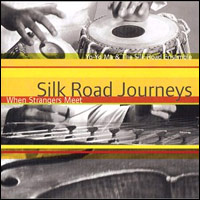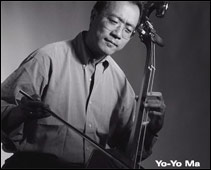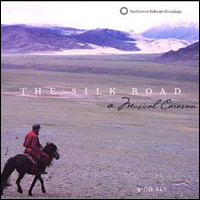|
Music Review by Lou Wigdor Silk Road Extravaganza—Let a Thousand Musical Hybrids Bloom |
 “To
me this recording is an answer to the question, “What happens when
strangers meet?” observes Yo-Yo Ma in the liner notes of his recent
CD, Silk Road Journeys (Sony). As most reviewers have noted,
what happens (on both the CD and in concert) has often been
intriguing. Intriguing and frequently satisfying, but rarely a musical
experience that might have you renting out your condo and hopping the
next Orient Express. Perhaps my expectations were inflated, because of
the caliber of Mr. Ma’s musical collaborators. All twenty-three
musicians on the CD are world-class players; Wu Man on the four-string
Chinese pipa (lute) and Kayhan Kalhor on the kamanche (a Persian
ancestor of the violin) are every bit Mr. Ma’s musical equals-that’s
to say that they’re awesome virtuosos. “To
me this recording is an answer to the question, “What happens when
strangers meet?” observes Yo-Yo Ma in the liner notes of his recent
CD, Silk Road Journeys (Sony). As most reviewers have noted,
what happens (on both the CD and in concert) has often been
intriguing. Intriguing and frequently satisfying, but rarely a musical
experience that might have you renting out your condo and hopping the
next Orient Express. Perhaps my expectations were inflated, because of
the caliber of Mr. Ma’s musical collaborators. All twenty-three
musicians on the CD are world-class players; Wu Man on the four-string
Chinese pipa (lute) and Kayhan Kalhor on the kamanche (a Persian
ancestor of the violin) are every bit Mr. Ma’s musical equals-that’s
to say that they’re awesome virtuosos.So why is my applause at times one-handed? In truth, I expected more in the way of extended commissioned works. The three compositions on the CD that qualify range from eleven to fifteen minutes and comprise just over half of the disc’s nearly eighty minutes. As far as I know, that is the recorded legacy to date of commissions by the 2+ year-old Silk Road Project. Also included on the CD are spirited performances of shorter, traditional works from Mongolia, China, and Persia. And there are instrumental renditions of two Saami folksongs from Finnish Lapland (composed by a Japanese), a snippet from Tan Dun’s score for the film Crouching Tiger, Hidden Dragon, and a cross-cultural instrumental arrangement of a Venetian Renaissance song, evocative of that city’s past as a commercial/cultural nexus between West and East. The three composers responsible for the CD’s
extended contributions all hail from Silk Road countries. All have
conservatory training in Western classical music. In the first of the longer works (track 2),
The Legend of Herlen, Mongolian composer Byambasuren Shaarav
adds escalating gusto to a three- and four-note scalar motif by the
inspired employment of a Mongolian horsehair fiddle—the morin
khuur (convincingly played by
You have to wait until track nine for the disc’s second “big” piece—Azerbaijani Franghiz Ali-Zadeh’s In Habil’s Style. (I’m not entirely sure if Habil is a commission, although it has been tailored for Mr. Ma’s virtuosity.) Scored for cello and prepared piano, it’s an unabashed vehicle for Mr. Ma, who never disappoints. With emotions characteristically on his sleeve, Yo-Yo and his cello traverse increasingly sinuous musical contours, evoking a wealth of affective nuances. Immediately chasing Habil is the CD’s longest track, Kayhan Kalhor’s Blue as the Turquoise Night of Neyshabur, positioned toward the CD’s end as a sort of culminating work. It is a thoroughly predictable pastiche of high-gloss Eastern textures and classical neo-romanticism. But in all fairness to Kalhor, who has composed an expertly-crafted crowd pleaser, risk taking and surprise were surely not his intent. Turquoise does come off, though as Orientalism, and Orientalism by a Persian, no less! But why this Persian? Kalhor is one of the most consistently inventive, dynamic string improvisers on the planet. And he’s got the albums to prove it. Just listen to his recent collaborations with fellow Persians Shajarian and Alizadeh, his work in the duo, Ghazal, and especially his own extraordinary album, Scattering Stars like Dust (Traditional Crossroads). “We weren’t aiming for a new music audience in
our commissions,” observed Ted Still, Herlen and Habil—no less accessible than Turquoise—consistently challenge the listener where the latter does not. But Kalhor has assumed the tougher compositional task. By and large, Herlen and Habil pursue the linear-monophonic musical strategies of their Eastern cultural origins, at times adding inspired scoring to the mix. Not so Turquoise, which expropriates Eastern melodic and textural influences into a very different context—full-scale Western polyphonic classical neo-romanticism. In the process, Kalhor fails to jettison enough late 19th century Western harmonic language to allow for challenging, idiomatic melodic exploration. But pulling off such a tour de force is no cake walk. Bartok and Ives spent years getting it right. In his early attempt, Kalhor got part way there to the approval of many in his audiences. A Silk Road Project undertaking without
a quaver of controversy is The Silk Road: A Musical Caravan, a
two-CD set issued last spring by Smithsonian Folkways. Expertly The traditions on Caravan and throughout the Silk Road are largely monophonic and improvisational. How, I asked Levin, are the Westerner musicians who tour with Yo-Yo and his project faring with the challenge of improvisation? “When we began more than two years ago, the Westerners were essentially stuck with their heads in their scores,” he remarked. “Gradually they became more self-assured and began taking some improvisatory chances. Some of our recent commissions, in fact, notate themes and their development and then allow for improvisatory options. It’s a bit like modern jazz. Compositional experimentation and many of our other activities reflect a crucial fact about the Silk Road Project—it’s a work in progress. Our marketing might suggest otherwise, but our activities are consistently fluid and exploratory.” Yo-Yo Ma, Levin continued, is committed to another three or four years with the project. After that, there’s the possibility of giving it permanence in an academic setting. Keeping things going, Levin notes, makes added sense, when you consider the centuries of distance between Eastern and Western musical traditions. The Silk Road Project’s participants may no longer be strangers, but they still have much to learn from one another and from the unintended consequences of their collaborations. |
|
|
 Mr. Ma). The composer turns up the
heat further with piano, three trombones, assorted percussion
(including bells and blocks that emulate horse hooves), and the vocals
of Ganbaatar Khongorzul. Near the end, Ms. Khongorzul’s voice
slices through the musical tableau like a scimitar, bringing searing
intensity to the music.
Mr. Ma). The composer turns up the
heat further with piano, three trombones, assorted percussion
(including bells and blocks that emulate horse hooves), and the vocals
of Ganbaatar Khongorzul. Near the end, Ms. Khongorzul’s voice
slices through the musical tableau like a scimitar, bringing searing
intensity to the music.  Levin, a professor of music at
Dartmouth College, who is Curatorial Director of the Silk Road
Project. Levin is author of 100,000 Fools of God (Indiana
University Press), an insightful, highly readable ethnomusicological
volume based on his multiple visits to Khazakstan, Uzbekstan, and
Tajikistan. “We rejected, in fact, a number of accomplished
submissions because the musical language was too abstruse.” The goal
of the commissions, he emphasized, has been to bridge East and West
for an informed, broad-based listening public. To that end,
Turquoise has been highly successful. “Audiences have consistently
enjoyed the piece, which was inspired by the composer’s reflections on
Neyshabur, an ancient, fabled city and cultural center in Northeast
Iran’s Khorisan province. [Neyshabur, which remains a significant
source of turquoise, was the home of great Persian poets, including
Attar-e and Omar-e-Khayyam.] So Kayhan, who incidentally did not
arrange Turquoise, was painting the ancient city from an
imaginative distance. But, the piece, I’ll grant you, may well hold a
place in the lineage of Rimski-Korsakov’s Sheherazade.”
Levin, a professor of music at
Dartmouth College, who is Curatorial Director of the Silk Road
Project. Levin is author of 100,000 Fools of God (Indiana
University Press), an insightful, highly readable ethnomusicological
volume based on his multiple visits to Khazakstan, Uzbekstan, and
Tajikistan. “We rejected, in fact, a number of accomplished
submissions because the musical language was too abstruse.” The goal
of the commissions, he emphasized, has been to bridge East and West
for an informed, broad-based listening public. To that end,
Turquoise has been highly successful. “Audiences have consistently
enjoyed the piece, which was inspired by the composer’s reflections on
Neyshabur, an ancient, fabled city and cultural center in Northeast
Iran’s Khorisan province. [Neyshabur, which remains a significant
source of turquoise, was the home of great Persian poets, including
Attar-e and Omar-e-Khayyam.] So Kayhan, who incidentally did not
arrange Turquoise, was painting the ancient city from an
imaginative distance. But, the piece, I’ll grant you, may well hold a
place in the lineage of Rimski-Korsakov’s Sheherazade.” compiled and annotated by Levin and French ethnomusicologist Jean
During, the collection, which emphasizes recent field recordings—many
of them by Levin and During themselves—covers vast cultural turf from
Armenia to China. One listener advisory, though, is in order: the
collection is overwhelming. Its forty-seven well-recorded tracks
document one astounding virtuoso after another. There are masters of
the Armenian duduk, the Azerian saz, the Iranian ney, the Chinese pipa
and guquin, the Kyrghiz kormuz, the Kazakh dombra, and dozens of other
instruments. It’s best to sample the set in discrete doses or prepare
for multicultural vertigo. There’s never been a collection though that
brings together as much judiciously chosen, well-recorded source
material on the region. And at under twenty dollars, the two-disc set
is a steal.
compiled and annotated by Levin and French ethnomusicologist Jean
During, the collection, which emphasizes recent field recordings—many
of them by Levin and During themselves—covers vast cultural turf from
Armenia to China. One listener advisory, though, is in order: the
collection is overwhelming. Its forty-seven well-recorded tracks
document one astounding virtuoso after another. There are masters of
the Armenian duduk, the Azerian saz, the Iranian ney, the Chinese pipa
and guquin, the Kyrghiz kormuz, the Kazakh dombra, and dozens of other
instruments. It’s best to sample the set in discrete doses or prepare
for multicultural vertigo. There’s never been a collection though that
brings together as much judiciously chosen, well-recorded source
material on the region. And at under twenty dollars, the two-disc set
is a steal.